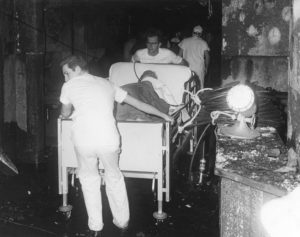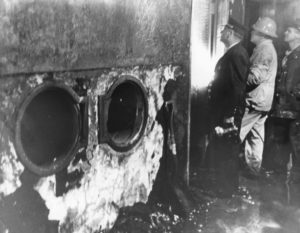By Elizabeth Correia
On December 8, 1961, the casual disposal of a cigarette spread raging flames and deadly smoke through Hartford Hospital. The fire ravaged the ninth floor and killed 16 individuals; it also necessitated the creation of many fire prevention and escape plans that we take for granted today.
Fire Consumes the Ninth Floor
On an average day in 1961, the ninth floor of the Hartford Hospital held 216 patients, four to each room. It also contained a trash chute labeled, “Dry trash only. For safety of incinerator attendant, burnable waste only,” which seemed like the appropriate place to dispose of cigarette butts. However, few outside of the maintenance staff knew that the chute, which connected all 13 floors of the hospital, did not empty directly into an incinerator. Instead, refuse sat in large cans in the basement until removed.
Janitor Arthur LaFontaine was usually the one to empty these cans. When passing the first-floor trash chute on December 8th he saw smoke coming from inside. Immediately LaFontaine worked to squelch the fire with a fire hose. Having witnessed controllable fires in the trash chutes before, staff believed the fire to be contained. Then, Nurse Sonia Sandner saw smoke coming from the ninth-floor chute door and rushed to close fire doors. At 2:39 pm , an hour after LaFontaine initially saw smoke, a nurse on the twelfth floor sounded the fire alarm and panic ensued.
An explosion from the trash chute erupted into the ninth floor of the hospital, blasting the chute door to the opposite side of the corridor. Flames emanating from the open chute eagerly consumed linoleum wainscotting, wallpaper, and cane-fiber ceiling tiles in the hallway. The burning building materials created clouds of black smoke so dense that it was nearly impossible for anyone to see. Hospital staff formed a line, moving patients from one person to the next toward the stairwell, some still in beds and wheelchairs.
Employees, patients, and visitors who decided to close themselves in patient rooms blocked gaps under doors with wet linens to prevent asphyxiation. If they managed to do this before shifting pressure pushed open their rolling door latches, they survived. Anyone running out of their room, opening doors along the way, inadvertently spread smoke and heat.

Hospital staff move seriously ill patients out of danger. Source: The Hamilton Archives at Hartford Hospital.
City firemen soon arrived only to find that their ladders reached just short of the ninth floor. At that point, firefighter Richard Trejarian jumped from the top of a ladder into a ninth-story window and began instructing those inside.
Dr. Norman Hedenstad took it upon himself to enter the ninth floor in a rescue effort, passing charred bodies as he searched for survivors. For his heroism, he lost his life, along with fifteen others whose ages ranged from 14 to 87. By 4:00 pm , firefighters managed to completely extinguish the fire.
Lessons Learned
In the aftermath of the fire, officials began updating the Connecticut Safety Code by limiting smoking and banning flammable building materials in hospitals. The Hartford Hospital underwent a $600,000 fire safety renovation that became a model for other hospitals in the state. This included the disconnection of trash holding cans from corridors, the upgrade of cumbersome single-piece fire doors to double doors, the installation of an emergency intercom system, and the elimination of dead-end hallways longer than 15 feet. In addition, Hartford Hospital formed a fire safety committee and employees underwent fire protection training. To this day the hospital exceeds the Connecticut Fire Code requirements, aware of the devastating consequences that come from being unprepared.
Elizabeth Correia holds an MA degree in Public History from Central Connecticut State University and works in cultural resource management.










